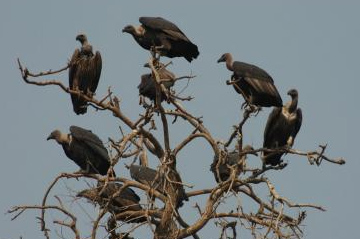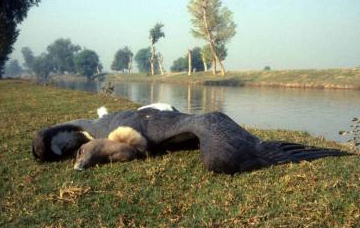Drug use blamed as vulture population crashes 99% in India and Pakistan
Drug use blamed as vulture population crashes 99% in India and Pakistan
Jeremy Hance, mongabay.com
September 9, 2008
More efforts required to save Asian vulture after unprecedented decline
|
|
Captive breeding programs are not large enough to ensure the oriental white-rumped vulture’s survival, reports a new study in Biological Conservation. Circling vultures used to be a common sight in India and Pakistan, but in less than twenty years their populations have crashed by 99 percent.
The cause was a drug called diclofenac used on livestock. When an animal died they were taken to dumps where the vultures fed. Consuming a carcass that contains diclofenac proved fatal: within a few days the vulture’s kidneys failed. Tens of millions of vulture perished due to the drug.
The oriental white-rumped vulture has gone from an estimated 40 million to a few thousand. While conservation measures are now in place, biologists are concerned that the loss of genetic diversity may doom the species. To address this concern, Jeff A. Johnson tested the vulture’s current population both in the wild and captivity.
 Vultures roosting in Pakistan. Photo by Munir Virani |
Johnson found that wild populations still retained a healthy amount of genetic diversity. However, computer simulations showed that captive populations are not currently large enough to retain this diversity. Therefore, if wild populations disappear entirely—which is a good possibility considering the continued use of diclofenac—these captive populations may not possess the genetic diversity necessary to save the species from eventual extinction.
"One of my goals with this paper," Johnson said, an assistant research scientist at the University of Michigan, "is to raise awareness of the problem and to increase political will in India and Pakistan to get this matter resolved."
Biologists first noticed a decline in Asian vultures in the mid-1990s. The sky’s greatest scavengers were found dead beneath their roosting trees. For years the cause remained a mystery. In 2003 the culprit was discovered. Although, diclofenac, an anti-inflammatory drug, was initially developed for humans, it began to be used on livestock to alleviate arthritis-like symptoms. In 2006 India, Nepal, and Pakistan outlawed the manufacture of diclofenac, however the drug is still being used.
 Dead vulture in Pakistan. Photo by Munir Virani |
"We know the problem, and we know the solution," said Johnson. "We just need to get diclofenac out of the environment and more birds into protection before it is too late." Two other species of Asian vultures have crashed due to diclofenac: the long-billed vulture, and the slender-billed vulture.
While the site of vultures on a carcass may be distasteful to some, they play a vital ecological role. For centuries these great birds have efficiently devoured livestock carcasses in India and Pakistan. Without vultures such carcasses can become a source of bacteria and a great attraction for feral dogs, which spread rabies.
The vulture also possesses a religious role in Hinduism. In the great epic Ramayana, Jatayu, the vulture saint, loses his life to the ten-headed Ravana. If more is not done to save these once-abundant vultures, the only Asian vulture left may be the mythological Jatayu.
Jeff A. Johnson, Martin Gilbert, Munir Z. Virani, Muhammad Asim, and David P. Mindell(2008). Temporal genetic analysis of the critically endangered oriental white-backed vulture in Pakistan. Conservation Biology, August 15 2008.